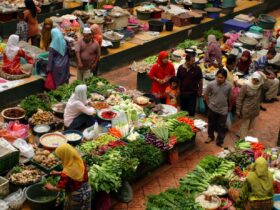COVID-19 pandemic impact on rice growers in Bangladesh
After fifty years of independence, Bangladesh has made significant progress in poverty reduction and food security. Bangladesh has abolished extreme poverty during the last few decades. Poverty levels have dropped from 48.9% to 23.2 percent. Bangladesh has also achieved self-sufficiency in the production of food grains. Bangladesh has made great progress in food grains, as well as rice (4th largest producer in the world), vegetables (3rd largest producer in the world), and mangoes over the last several decades (7th largest producer in the world). Bangladesh is also the world’s third-largest producer of inland fish, after India and China. Despite these accomplishments, there are still discrepancies in per capita demand for fruits, vegetables, eggs, milk, and other food products that contribute to meal nutrition and growth. The situation remains perilous as a result of the food security and malnutrition gap. In 2009, Bangladesh was rated 83rd in the world for food cost, availability, quality, and safety, as well as essential natural resources and resilience (Talukder et. Al.2021).
COVID-19’s impact on rice growers According to the IRRI (International Rice Research Institute), the impact of the COVID-19 pandemic on rice farmers in Bangladesh was relatively minimal compared to those producing high-value agricultural commodities such vegetables, fruits, poultry, fish, and animals.
According to the findings of a farmer survey, rice farmers are facing the following key issues as a result of COVID-19: Obtaining agricultural inputs (e.g., seeds for the forthcoming spring Aus and summer aman seasons, fertilizers, insecticides, and fuel to run irrigation pumps), new rice varieties, and extension services were all mentioned by more than 70% of respondents.
According to FAO research, more than 90% of farmers polled noted a lack of labor and machinery for harvesting and threshing boro rice and planting Aus rice.
COVID 19 is for you. Seasonal labor for rice harvesting was scarce due to the lockdown and transportation restrictions. The Ministry of Agriculture, on the other hand, played a critical role in facilitating agricultural labor migration and the delivery of combine harvesters.
In addition, migrant workers who returned to their communities as a result of COVID-19 partially replaced hired laborers for rice planting and harvesting, although boro harvesting wages remained high, increasing by 10 to 20% in 2020 compared to the same months in 2019.
Thirty percent of farmers said labor shortages caused them to miss out on harvesting rice. It has raised the potential of early flash floods, which can cause crop damage. However, 40% of farmers said they were having trouble selling their rice due to disruptions in logistics, supply chains, and the closure of local marketplaces.
Due to rising transportation costs and the limited functioning of market venues, around 60% of farmers reported an increase in rice marketing costs. Seed entrepreneurs experienced difficulties harvesting, processing, packaging, storing, and distributing high-quality seeds due to a lack of seed technologists, labor scarcity, poor storage facilities, and mobility restrictions.
These variables are expected to result in a shortage of high-quality seeds next year. COVID-19 had a good influence on rice producers as well. In comparison to the previous year, more than 90% of farmers reported a 20 to 30% increase in paddy farm gate prices this year. The reason for this was that traders and rice millers were buying and storing paddy in expectation of a future price increase, but this is bad for the common public.
You may read: Organic Agriculture Introduction – Agribusiness Education and Research International
You may read: What is Sustainable Agriculture? – Agribusiness Education and Research International
What is Permaculture? – Agribusiness Education and Research International
You may read: What is Agribusiness? – Agribusiness Education and Research International
You may read: Agribusiness in Bangladesh – A Basic Introduction – Agribusiness Education and Research International
You may read: Covid -19 Pandemic Impact on Agribusiness – Agribusiness Education and Research International
What is Agricultural Technology? – Agribusiness Education and Research International
Planting System and Sustainable Agriculture – Agribusiness Education and Research International
Operation Research in Agriculture – Agribusiness Education and Research International
Join our LinkedIn group
https://www.linkedin.com/groups/13943442/
Join our Facebook group
https://www.facebook.com/groups/agribusinesseducationandresearchinternational
Reference:
- Talukder, B., Hipel, K. W., & Orbinski, J. (2021). COVID-19’s implications on agri-food systems and human health in Bangladesh. Current Research in Environmental Sustainability, 3, 100033.
- Bangladesh Second Country Investment Plan Nutrition-Sensitive Food Systems (CIP2 2016-2020) ,Monitoring Report 2021






Leave a Reply